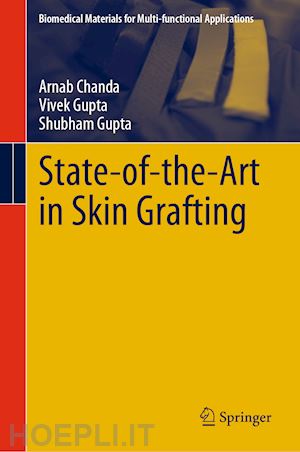
Questo prodotto usufruisce delle SPEDIZIONI GRATIS
selezionando l'opzione Corriere Veloce in fase di ordine.
Pagabile anche con Carta della cultura giovani e del merito, 18App Bonus Cultura e Carta del Docente
This book discusses the different skin grafting methods, latest trends in graft designing, and its relationship with the burn injuries. An introduction to several conventional and modern skin grafting methods and how crucial the innovation is for recovery of large burns will be presented. The technologies involved in the development of skin grafts incisions, and study of their effect on the mechanical properties and systematically modified skin graft patterns, will be covered at length. The development of skin grafts using conventional, auxetic, and hierarchical patterns through computational and experimental frameworks will be discussed in detail. Also, the role of skin graft patterns on the mechanical stresses, expansion ratio or meshing ratio, will be presented. Additionally, the role of degree of burn, size of burn, and region of burn will be discussed, and its generalizability will be covered in detail. Finally, the challenges with the existing skin graft meshers and latest development in this niche area will be highlighted. This book is anticipated to serve as a key reference for medical and research professionals working in the skin grafting domain as well as the product manufacturing industries. For example, skin grafting plays an important role to cure the serious burn injuries. Current innovative skin graft patterns which cover higher area compared to traditional skin graft patterns are anticipated to help in surgery and faster recovery of larger burnt areas. Also, the current skin graft mesher, which is used to develop traditional skin grafts, cannot produce claimed expansions clinically. This book helps design novel mesher devices to reduce the difference between actual and claimed expansions clinically and increase the skin graft coverage area to recover burn sites with lesser available skin. This book is equally useful for students of medical practices, manufacturing engineering, and design engineering.
PART I. Skin and Burn Injuries.- Chapter 1. Introduction to Skin and Injuries.- Chapter 2. Worldwide Statistics on Skin Related Injuries.- Chapter 3. Prevalence of Burn Injuries in Specific Sectors.- Chapter 4. Types of Burn Injuries.- PART II. Traditional Skin Grafting Methods.- Chapter 5. Traditional Skin Grafts.- Chapter 6. Background on Skin Graft Meshers.- Chapter 7. Computational Analysis of Traditional Skin Grafts.- Chapter 8. Experimental Analysis of Traditional Skin Grafts.- Chapter 9. Clinical Testing and Applications of Traditional Skin Grafts.- Chapter 10. Disadvantages of Traditional Skin Grafting Technologies.- PART III. Modern Skin Grafting Methods.- Chapter 11. Current Trends in Expansion of Skin Grafts.- Chapter 12. Computational and Experimental Analysis of Different Auxetic Patterns.- Chapter 13. Computational and Experimental Analysis of Alternating Slits based Skin Graft Patterning.- Chapter 14. Computational and Experimental Analysis of Rotating Triangles basedSkin Graft Patterning.- Chapter 15. Computational and Experimental Analysis of I-Shaped based Skin Graft Patterning.- Chapter 16. Computational and Experimental Analysis of Hierarchical based.- Chapter 17. Challenges in Implementation of Innovative Skin Grafts.
Dr. Arnab Chanda is an assistant professor in the Centre for Biomedical Engineering, IIT Delhi, and a joint faculty at the Department of Biomedical Engineering at AIIMS, Delhi. He is also the founder of a start-up company BIOFIT Technologies LLC, USA. Dr. Chanda is an expert in the fabrication and manufacturing of artificial tissues, sensors, and wearable robotic devices. Also, his work has been cited extensively, and he is a recipient of the “Early Career Award” in 2024, “IOP Publishing?Top Cited Paper Award” in 2023, and the “AO Spine National Research Grant Award” in 2022 by the prestigious AO Foundation, Davos, Switzerland. His research also received extensive media coverage, with over five articles cited in The Times of India.
Dr. Vivek Gupta is a senior mechatronics engineer at Next Big Innovation Labs® (NBIL), where he designs and develops 3D Bioprinters for biomedical applications. He manages projects from conception to completion, ensuring adherence to budgets and timelines, and collaborating closely with cross-functional teams. He also designs control algorithms, part design and assembly, and embedded software for the 3D Bioprinters, using Autodesk EAGLE and other tools. Prior to this, Dr. Vivek has completed his Ph.D. in Biomedical Engineering from the Indian Institute of Technology Delhi (IITD), where he conducted groundbreaking research on skin grafting and auxetic structures, aiming to improve the care of severe burn patients. He has authored 22 international journal articles, including 18 as the first author, and has been awarded multiple patents for his innovations. Dr. Vivek is passionate about making India self-dependent in surgery and creating new technologies that can enhance human health and well-being.
Shubham Gupta is a Ph.D. scholar and Prime Minister Research Fellow (PMRF) in the Disease and Injury Mechanics Lab (DIML), IIT Delhi, headed by Dr. Arnab Chanda. He completed his B.Tech. in Mechanical Engineering from the University of Pune in 2019. His research is focused on the study of traction performance of worn footwear. He was instrumental in the development of a state-of-the-art portable footwear traction characterization device and has also experimented with a range of worn footwear to estimate their traction reduction and determine replacement thresholds. Shubham has also developed a pioneering computational fluid dynamics-based (CFD) model to study the underlying physics behind the traction properties presented by a new or worn footwear on slippery fluid-contaminated floorings. His research interests are computational analysis of footwears, slip testing, finite element modeling, healthcare product development, and integration of robotics and AI/ML in medical applications.











Il sito utilizza cookie ed altri strumenti di tracciamento che raccolgono informazioni dal dispositivo dell’utente. Oltre ai cookie tecnici ed analitici aggregati, strettamente necessari per il funzionamento di questo sito web, previo consenso dell’utente possono essere installati cookie di profilazione e marketing e cookie dei social media. Cliccando su “Accetto tutti i cookie” saranno attivate tutte le categorie di cookie. Per accettare solo deterninate categorie di cookie, cliccare invece su “Impostazioni cookie”. Chiudendo il banner o continuando a navigare saranno installati solo cookie tecnici. Per maggiori dettagli, consultare la Cookie Policy.